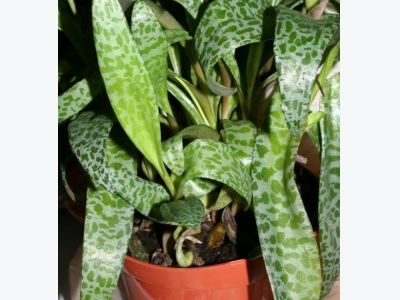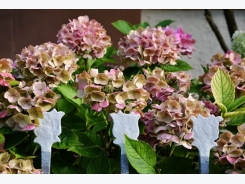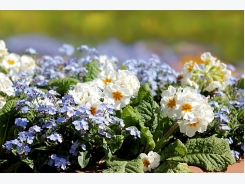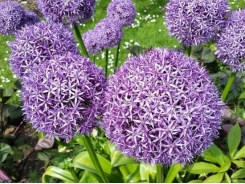Caring for Potted Plants

Do you have an illustrious green thumb? The truth is, you probably do. You just may not know it. With patience, a bit of general plant care knowledge and some tips from the experts, your thumb can be green in no time.
The perfect place to start to develop your green thumb is right in the comfort of your own home. A potted patio or houseplant is often an inexpensive and simple way to begin. Potted plants not only give you the chance to cultivate the grower in you, but they bring a touch of living energy and color into your home and life.
Potted plant success is largely dependent on a few basic rules. Houseplants need good light, the right kind of soil, the proper amount of water, and a little love. Simple enough. And with the following list of best practices, you can't go wrong.
What type of pot should I choose for my houseplant?
Believe it or not, one of the most important choices you can make when growing a potted plant is in regard to the size and type of pot. Houseplants are usually purchased in appropriate sized containers. Often, the plant will need to be repotted within a year or two as growth of both the plant itself and its roots occurs.
Your pot has become too small when the roots extend through the drainage hole in the bottom of the pot. On the other hand, a pot that is too big will allow the plant to grow too rapidly, and you will need to repot sooner. Choose a happy medium-sized pot that corresponds with your plant's size. Allow enough space at the top of the pot to water easily.
What type of pot you choose will make a difference when it comes to watering. Clay pots are porous, so the soil will dry out more quickly than a glazed or a plastic pot.
Speaking of watering, make sure your new pot has at least one drainage hole in the bottom. There is not a houseplant alive that enjoys soggy feet. Drainage is essential for your plant's overall health. If your pot doesn't have a drainage hole, place a layer of rocks at the bottom of the pot where water can drain away from the plants roots. You will want to place a tray under your indoor potted plant to catch extra water.
For a step by step tutorial and other tips on selecting a pot and re-potting check out:
What type of soil is best for potted plants?
If you think that soil is just dirt, think again. Your houseplant will respond to the difference between a good mix versus a soil of poor quality. Even soil that is good quality in your outdoor garden is not appropriate for a potted plant. The right soil for a potted plant is potting soil.
Potting soil is the right choice for your houseplant because it is specially formulated to allow for drainage within a container and to promote air circulation to the roots. Potting soil is also infused with moisture-retaining elements and with minerals that nourish the plant.
For a homemade potting soil, mix together the same amounts of vermiculite or perlite to peat moss or sphagnum moss. Add some outdoor garden soil for bulk if needed. A bit of sawdust, shredded bark, or lime should be added to balance the acid levels in your mix. Finally, add some fertilizer. Your potted plant will love it.
How much light?
While all houseplants need light, there is quite a bit of variation in regard to exactly how much. You will want to match a location to the variety of plant. So, before you purchase your houseplant, scope around your home and decide where you would like to place your new plant. When you choose the location first, you can select a plant based on the lighting in that particular area of your home.
For a sunny southern windowsill, a succulent jade plant or a Christmas cactus is a good choice. For indirect sunlight, try a prayer plant or an English ivy. If you have an area with low light, choose a split leaf philodendron or a Boston fern. Flowering plants require many hours of indirect sunlight every day, so a north-facing window would work well.
To achieve the proper amount of light for your plant even in the darkest of corners, you can provide artificial light to your plants. A fluorescent light placed about one foot away from the top of the plant for sixteen hours a day will provide light enough for a healthy houseplant.
Best watering practices
When it comes to potted plant health, proper watering will hands down be your biggest challenge. Watering your potted plant requires a vigilant balance between too moist and too dry. Even short periods of either extreme will jeopardize the overall health of your plant.
Just as there are differences in lighting needs for different types of plants, there is a range of watering requirements for houseplants, too. It is important to be aware of the watering requirements that best suit the plant you have selected.
There are two primary ways to water your potted plant. You can water from the top of the pot by pouring water into the soil around the base of your plant. You can also place your potted plant into a bucket of water up to the rim of the pot. The roots and soil will absorb the water through the drainage hole. Remove the plant from the water when the soil on top is moist. If you choose this method for watering, water from the top occasionally to rinse minerals back down into the soil toward the roots.
In general, by observing your plant and the soil around it, you can learn to recognize its moisture level. You can stick your finger into the soil around your plant to determine if it is wet, moist, or dry. You might also consider buying a water meter from your local nursery. A water meter is an inexpensive tool that tells you exactly the moisture level around your plant.
Too much watering will cause your plant to be vulnerable to root rot, leaf yellowing, and leaf drop. If your plant's soil becomes too dry, your plant will wilt and become more susceptible to spider mites and other pests.
Potted plant pests and problems
With proper care and attention, your potted plant should flourish. When you decide to add a companion to your first successful potted plant, keep it apart from your original plant in case the new plant has pests.
If you discover that your plant has become infested you may be able to rinse or spray your plant clean. For flying pests, try yellow sticky traps. If your plant becomes heavily infested, you will probably want to discard the plant and begin again.
Có thể bạn quan tâm
Phần mềm

Phối trộn thức ăn chăn nuôi

Pha dung dịch thủy canh

Định mức cho tôm ăn

Phối trộn phân bón NPK

Xác định tỷ lệ tôm sống

Chuyển đổi đơn vị phân bón

Xác định công suất sục khí

Chuyển đổi đơn vị tôm

Tính diện tích nhà kính

Tính thể tích ao hồ




 How to Grow Catmint
How to Grow Catmint  Care for Fall Flowering Bulbs
Care for Fall Flowering Bulbs